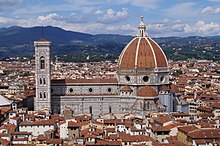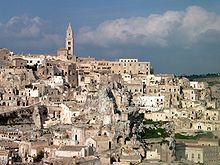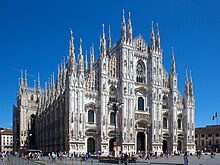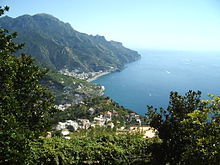





Tourism in Italy is one of the largest economic sectors of the country. With 60 million tourists per year (2023), Italy is the fourth most visited country in international tourism arrivals. According to 2018 estimates by the Bank of Italy, the tourism sector directly generates more than five per cent of the national GDP (13 per cent when also considering the indirectly generated GDP) and represents over six per cent of the employed.[7][8]
People have visited Italy for centuries, yet the first to visit the peninsula for tourist reasons were aristocrats during the Grand Tour, beginning in the 17th century, and flourishing in the 18th and 19th centuries.[9] This was a period in which European aristocrats, many of whom were British and French, visited parts of Europe, with Italy as a key destination.[9] For Italy, this was in order to study ancient architecture, local culture and to admire the natural beauties.[10]
Nowadays the factors of tourist interest in Italy are mainly culture, cuisine, history, fashion, architecture, art, religious sites and routes, naturalistic beauties, nightlife, underwater sites and spas. Winter and summer tourism are present in many locations in the Alps and the Apennines,[11] while seaside tourism is widespread in coastal locations along the Mediterranean Sea.[12] Small, historical and artistic Italian villages are promoted through the association I Borghi più belli d'Italia (literally "The Most Beautiful Villages of Italy"). Italy is among the countries most visited in the world by tourists during the Christmas holidays.[13] Rome is the 3rd most visited city in Europe and the 12th in the world, with 9.4 million arrivals in 2017[14] while Milan is the 5th most visited city in Europe and the 16th in the world,[15][16] with 8.81 million tourists.[17] In addition, Venice and Florence are also among the world's top 100 destinations. Italy is also the country with the highest number of UNESCO World Heritage Sites in the world (60).[18] Out of Italy's 60 heritage sites, 54 are cultural and 6 are natural.[19]
The Roman Empire, Middle Ages, Renaissance and the following centuries of the history of Italy have left many cultural artefacts that attract tourists.[20] In general, the Italian cultural heritage is the largest in the world since it consists of 60 to 75 percent of all the artistic assets that exist on each continent,[21] with over 4,000 museums, 6,000 archaeological sites, 85,000 historic churches and 40,000 historic palaces, all subject to protection by the Italian Ministry of Culture.[22] As of 2018, the Italian places of culture (which include museums, attractions, parks, archives and libraries) amounted to 6,610. Italy is the leading cruise tourism destination in the Mediterranean Sea.[23]
In Italy, there is a broad variety of hotels, going from 1-5 stars. According to ISTAT, in 2017, there were 32,988 hotels with 1,133,452 rooms and 2,239,446 beds.[24] As for non-hotel facilities (campsites, tourist villages, accommodations for rent, agritourism, etc.), in 2017 their number was 171,915 with 2,798,352 beds.[24] The tourist flow to coastal resorts is 53 percent; the best equipped cities are Grosseto for farmhouses (217), Vieste for campsites and tourist villages (84) and Cortina d'Ampezzo mountain huts (20).[25][26]
- ^ "Top 10 most Beautiful Cities in the World 2017". 28 July 2016.
- ^ "Top 10 most Beautiful Cities in the World 2018". 2 September 2018.
- ^ "The Duomo of Florence | Tripleman". www.tripleman.com. Archived from the original on 6 December 2009. Retrieved 25 March 2010.
- ^ "brunelleschi's dome - Brunelleschi's Dome". Brunelleschisdome.com. Archived from the original on 16 April 2010. Retrieved 25 March 2010.
- ^ Fodor's Southern Italy, Fodor's Travel, 22 March 2011
- ^ "Milan Attractions". The New York Times. Archived from the original on 4 June 2009.
- ^ "The weight of tourism in Italy, the characteristics of the demand and the accommodation capacity" (PDF). 11 December 2018. Event occurs at Bank of Italy.
- ^ UNWTO Tourism Highlights, 2015 Edition. 2015. doi:10.18111/9789284416899. ISBN 9789284416899.
- ^ a b Cite error: The named reference
grand-tourwas invoked but never defined (see the help page). - ^ Cite error: The named reference
gettywas invoked but never defined (see the help page). - ^ "VACANZE IN MONTAGNA IN ITALIA: IN INVERNO E IN ESTATE" (in Italian). 30 July 2017. Retrieved 1 January 2022.
- ^ "Il turismo balneare" (in Italian). 14 February 2018. Retrieved 1 January 2022.
- ^ Cite error: The named reference
turismo-natalewas invoked but never defined (see the help page). - ^ "Ranking the 30 Most-Visited Cities in the World". TravelPulse. Archived from the original on 11 July 2019. Retrieved 16 April 2022.
- ^ "Milano è la seconda città più amata dai turisti in Italia dopo la capitale" (in Italian). Retrieved 1 December 2023.
- ^ "Global Destination Cities Index 2019 di Mastercard: aumentano i turisti che scelgono l'Italia" (in Italian). Archived from the original on 6 November 2019. Retrieved 26 March 2020.
- ^ "Global Destination Cities Index by Mastercard, 2018 edition". Archived from the original on 28 September 2018. Retrieved 28 April 2019.
- ^ "The World Heritage Convention". UNESCO. Archived from the original on 27 August 2016. Retrieved 1 August 2021.
- ^ Cite error: The named reference
italywas invoked but never defined (see the help page). - ^ "Viaggiare in Italia: giro turistico" (in Italian). Retrieved 31 December 2021.
- ^ "Il museo Italia. Siamo primi al mondo per patrimonio ma sappiamo valorizzarlo?" (in Italian). 17 June 2018. Retrieved 27 December 2021.
- ^ "L'Italia possiede un patrimonio culturale e ambientale unico al mondo" (in Italian). 10 October 2017. Retrieved 27 December 2021.
- ^ Cite error: The named reference
lagenziadiviaggiwas invoked but never defined (see the help page). - ^ a b Cite error: The named reference
hotelwas invoked but never defined (see the help page). - ^ "Turismo: 91% viaggiatori soddisfatti mete culturali Italia". Repubblica.it. 21 March 2019. Retrieved 26 July 2019.
- ^ "Turismo in Italia nel 2018 – Movimento dei clienti e capacità degli esercizi ricettivi" (PDF). istat.it. Retrieved 18 July 2019.